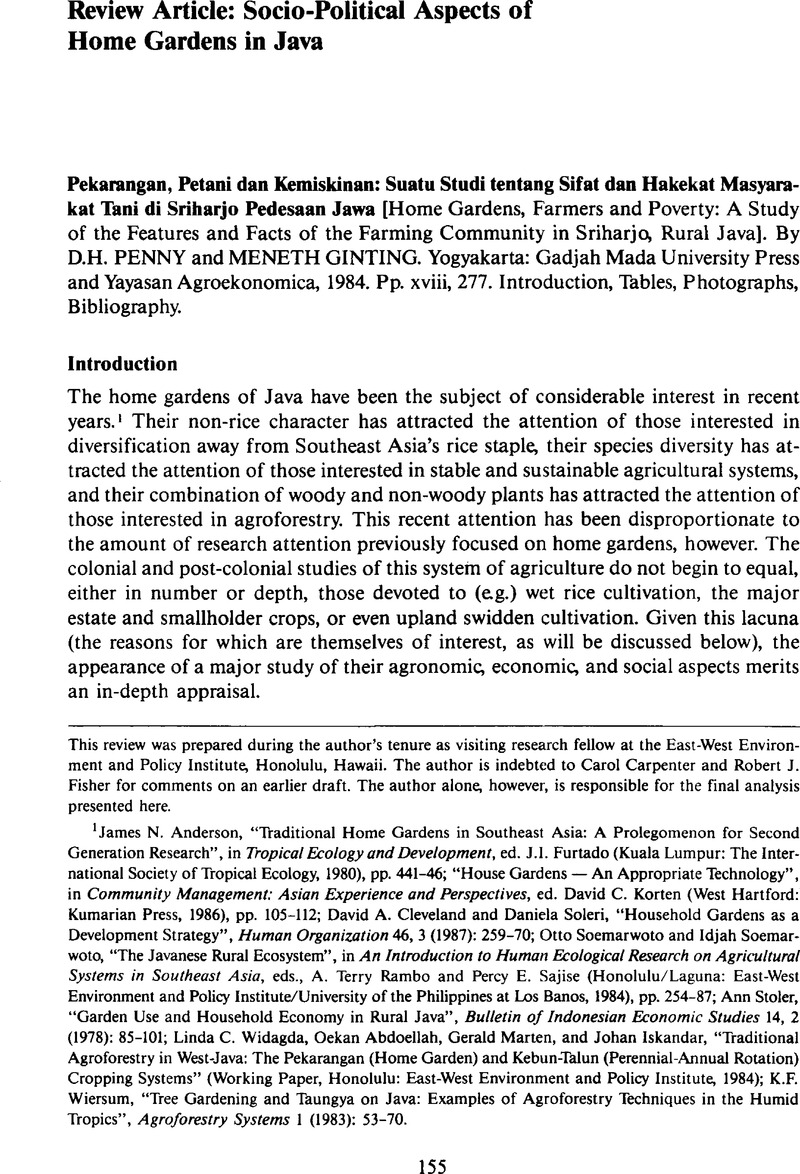Published online by Cambridge University Press: 24 August 2009

This review was prepared during the author's tenure as visiting research fellow at the East-West Environment and Policy Institute, Honolulu, Hawaii. The author is indebted to Carol Carpenter and Robert J. Fisher for comments on an earlier draft. The author alone, however, is responsible for the final analysis presented here.
1 Anderson, James N., “Traditional Home Gardens in Southeast Asia: A Prolegomenon for Second Generation Research”, in Tropical Ecology and Development, ed. Furtado, J.I. (Kuala Lumpur: The International Society of Tropical Ecology, 1980), pp. 441–46Google Scholar; “House Gardens — An Appropriate Technology”, in Community Management: Asian Experience and Perspectives, ed. Korten, David C. (West Hartford: Kumarian Press, 1986), pp. 105–112Google Scholar; Cleveland, David A. and Soleri, Daniela, “Household Gardens as a Development Strategy”, Human Organization 46, 3 (1987): 259–70CrossRefGoogle Scholar; Soemarwoto, Otto and Soemarwoto, Idjah, “The Javanese Rural Ecosystem”, in An Introduction to Human Ecological Research on Agricultural Systems in Southeast Asia, eds., Rambo, A. Terry and Sajise, Percy E. (Honolulu/Laguna: East-West Environment and Policy Institute/University of the Philippines at Los Banos, 1984), pp. 254–87Google Scholar; Stoler, Ann, “Garden Use and Household Economy in Rural Java”, Bulletin of Indonesian Economic Studies 14, 2 (1978): 85–101CrossRefGoogle Scholar; Widagda, Linda C., Abdoellah, Oekan, Marten, Gerald, and Iskandar, Johan, “Traditional Agroforestry in West-Java: The Pekarangan (Home Garden) and Kebun-Talun (Perennial-Annual Rotation) Cropping Systems” (Working Paper, Honolulu: East-West Environment and Policy Institute, 1984)Google Scholar; Wiersum, K.F., “Tree Gardening and Taungya on Java: Examples of Agroforestry Techniques in the Humid Tropics”, Agroforestry Systems 1 (1983): 53–70CrossRefGoogle Scholar.
2 Similar findings have been obtained elsewhere. For example, in a comparison of the famous wet-rice terraces and less-famous tuber gardens of the Ifugao, the latter were found to be more productive, whether this was measured in terms of return per unit of land area or unit of labour. See Dove, Michael R., “Review of H.C. Conklin's ‘Ethnographic Atlas of Ifugao’ and Its Implications for Theories of Agricultural Evolution in Southeast Asia”, Current Anthropology 24, 4 (1983): 518CrossRefGoogle Scholar.
3 Cf. Briscoe, John, “Energy Use and Social Structure in a Bangladesh Village”, Population and Development Review 5, 4 (1979): 615–41CrossRefGoogle Scholar.
4 This does not mean that the home garden was never subjected to any extraction at all. Both Raffles and Stoler (cited in Penny and Ginting, p. 192n) refer to a long history of government taxation of home gardens.
5 It is interesting that governments with radically different political philosophies from Indonesia's have felt obliged to take similar actions against home gardens (for what I deem to be similar reasons). Thus, in the 1960s and 1970s the government of the People's Republic of China outlawed the private ownership of home gardens, because too much productive effort was being devoted to them as opposed to the collective farmlands — and hence to the benefit of individual households as opposed to the state (personal communication from a knowledgeable Chinese researcher).
6 Hart, Gillian, Power, Labour, and Livelihood: Processes of Change in Rural Java (Berkeley: University of California Press, 1986)Google Scholar.
7 Dove, Michael R., “The Agroecological Mythology of the Javanese, and the Political Economy of Indonesia”, Indonesia 39 (1985): 12–13CrossRefGoogle Scholar.
8 Boeke, J.H., Economics and Economic Policy of Dual Societies as Exemplified by Indonesia (New York: Institute of Pacific Relations, 1953)Google Scholar.
9 Dove, Michael R., “The Myth of the Communal Longhouse in Rural Development”, in Too Rapid Rural Development, eds. MacAndrews, C. and Chin, L.S. (Athens: Ohio University Press, 1983), pp. 14–78Google Scholar.
10 Schultz, T.W., Transforming Traditional Agriculture (New Haven: Yale University Press, 1964)Google Scholar.
11 Elaborate, cultural strategies for protecting the wealth of peasant households against outsiders are well-documented in the anthropological literature. Cf. Charlotte, and Wiser, William H., Behind Mud Walls in India (London: George Allen, 1932)Google Scholar on the wisdom behind the decrepit walls of village India.